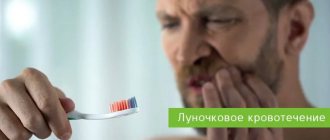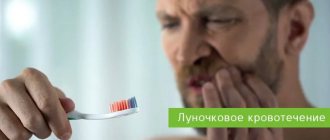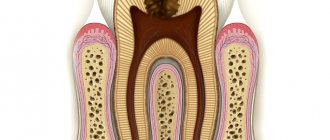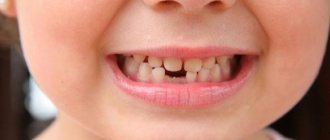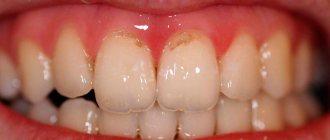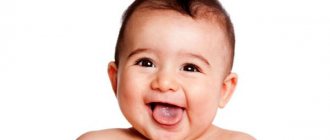The replacement of baby teeth with permanent ones is a natural physiological process that every child experiences. It usually begins in preschool age and proceeds without difficulty. But parents need to approach it responsibly, since any violations when changing teeth are fraught with unpleasant consequences. This may be the formation of a malocclusion, uneven teeth, or the occurrence of a diastema (interdental gap).
In this article we will consider the correct sequence of tooth replacement, possible violations, and situations when consultation with a pediatric dentist is necessary.
Why and when do baby teeth change?
As the child grows, the dentofacial apparatus also develops. At approximately 4–6 years of age, the preparatory stage begins, during which interdental spaces appear. This prepares the place for permanent teeth in the primary dentition.
The process of replacing baby teeth with permanent teeth is a slow process, taking approximately 6 or 7 years (until adolescence). Active growth of the roots of permanent teeth activates the process of bone resorption - this is the destruction (dissolution) of milk roots, which leads to loosening and tooth loss. Standard diagram of the sequence of changing baby teeth in a child.
- Central lower incisors (5–7 years). They fall out one by one with a short time interval.
- Lateral incisors (7–8 years).
- First molars on the upper jaw, second molars on the lower jaw (9–11 years)
- Cone-shaped teeth (canines) at the age of 9–12 years.
- Second molars on the upper jaw and first molars on the lower jaw (10–13 years)
Not everyone's third molars (wisdom teeth) erupt. This is considered the norm. Most often, the optimal age for them is considered to be from 17 to 25 years.
Reference!
The later the first teeth erupted in infancy, the later they will be replaced in preschool age.
By the age of 15–16, a teenager’s permanent bite should number 28 units.
Why do children lose teeth?
The formation of baby teeth in the jaw begins long before the baby is born. And the eruption of the first tooth becomes a real event. This usually happens at six months: parents notice bumps on the lower gum, the baby becomes capricious and restless. And after some time, the mouth is decorated with white “caps” of the first central incisors.
A little later, after two to four months, they are paired with the central incisors on the upper jaw. Then the lateral incisors, canines and molars appear in the mouth. The latter grow up by about two and a half to three years, and by this age most children acquire a complete milk bite. 20 baby teeth will serve the baby for at least another two to three years.
As the baby grows, his jaw also changes. It becomes larger, and if up to three years the teeth were arranged in dense, neat rows, then later gaps will begin to appear between them. Parents should not worry - this is a natural and necessary process. Interdental spaces, called diastemas, are needed so that later molars, larger than baby teeth, can take their place.
At the age of six or seven years, the changes become even more noticeable. The baby's first tooth may fall out. Usually, the one that appeared first, that is, the central incisor of the lower jaw, falls out first. This event indicates that the milk bite will begin to change into a permanent one. The baby’s body will need time to completely renew its dentition. This takes on average four to five years, and there is no need to rush things.
pixabay.com/
Parents are often worried that their children’s teeth are already actively changing, but their baby still walks around with a full, milky smile. These experiences are usually in vain, since nature has not programmed the only correct time for a person to change their bite. The indicated age for the loss of the first tooth is conditional. For some children this happens earlier - for example, at five years old. For others - after seven years, when the baby goes to school. It has been noticed that girls acquire molars earlier than boys. At the same time, the age at which baby teeth fall out is not as important as the correct order.
What deviations from the norm may there be?
Each child develops individually. Sometimes the timing of the replacement of certain teeth may differ from the generally accepted norm. Minor deviations are allowed up to 12 months. But sometimes the change in the primary bite begins too early or, on the contrary, the temporary teeth do not want to fall out.
Causes:
- long-term breastfeeding;
- severe infectious diseases in infancy;
- pathologies of intrauterine development.
Reference!
Dentists believe that a safer deviation is a late change in the primary occlusion than vice versa.
Let us consider in detail the common violations and their causes.
Early tooth loss
We can talk about such a pathology if a child’s baby teeth begin to fall out before the age of 5. Possible reasons:
- advanced multiple caries;
- injury;
- gum disease;
- manual loosening of the tooth.
In all these cases, consultation with a pediatric dentist is required.
Important!
Parents should record the time of tooth loss. If after 4 months the permanent tooth does not begin to emerge, then the help of a doctor is required.
In case of early unnatural tooth loss, it is advisable to conduct an X-ray diagnosis. This will help to identify possible damage to the permanent root rudiment in time and begin treatment. Otherwise, the child will need prosthetics in the future.
Late change from primary to permanent occlusion
The deadline for starting the process of changing baby teeth is 8 years. But this is considered a late shift. The disorder may be caused by:
- heredity;
- metabolic disorders;
- infectious diseases suffered in early childhood;
- mental disorders.
If after 8 years a child has not lost a single baby tooth, this is a reason to consult a doctor.
Caring for the socket of an extracted tooth
After tooth extraction, to prevent the development of complications and reduce the secreted ichor, as well as to speed up the healing of the wound, it is necessary to properly care for the resulting hole. To do this, you should adhere to the following recommendations:
- Hold the tampon with the medicinal substance applied by the dentist for thirty minutes;
- If a blood clot forms in the socket, it is not recommended to rinse it, spit it out, or remove it by other methods during the day;
- Do not disturb the damaged area by palpating with your tongue or other means;
- Do not chew food with the place where the tooth was removed, and do not suck any drinks through a straw for 24 hours;
- Limit or completely eliminate heavy physical activity;
- Avoid visiting bathhouses, saunas, taking hot showers and prolonged exposure to sunlight for a day;
- The use of warming compresses in the area of tooth extraction is prohibited;
- For three hours after surgery, you must stop eating;
- To avoid the development of swelling and pain, it is necessary to eat only warm foods and drinks for several days;
- Eliminate hot, spicy additives, as well as foods with sour and strong tastes for a couple of days. Such dishes can contribute to the opening of re-bleeding;
- If food particles get into the hole with a clot, you must rinse your mouth until they are completely removed. In this case, it is strictly forbidden to use a toothpick, fingers or other methods to clean the socket, since it is possible to disrupt the formed blood clot;
- Eliminate the use of alcohol and tobacco products for a period of three to seven days;
- After 24 hours after the operation, it is necessary to rinse the mouth with a soda solution or special antiseptic agents;
- When cleaning tooth enamel, it is necessary to perform this operation extremely carefully in the area of the extracted tooth;
What can and cannot be done after tooth extraction?
In case of individual intolerance to pain after tooth extraction, it is permissible to use medications against pain, which belong to the group of non-steroidal anti-inflammatory drugs. When performing surgery against the background of infectious diseases in the oral cavity, for further recovery it is necessary to take a course of antibiotics.
After the removal of a wisdom tooth, you must adhere to the same recommendations, the only difference is that the symptoms are more severe.
Reasons for late eruption
Normally, after a baby tooth falls out, it takes 1-2 months for the permanent tooth to erupt. This is the longest period. In most cases, the rudiments of a permanent tooth can already be seen at the site of the lost tooth.
But, if a child’s toothless smile persists for 3 months or more, then this is a cause for concern for parents.
Let's consider why such dental pathology occurs:
- Retention
– a common condition that mainly affects the incisors and canines. They cannot erupt due to dense gums or because they rest against neighboring teeth. There are complete and partial retention. With the full form, a healthy root is visible in the picture, but it is completely under the gum. With partial retention, only part of the crown is visible. In this case, surgical assistance is required.
- Edentia
– a congenital pathology in which there is a lack of rudiments of permanent dental units. Can be complete or partial (sparse teeth). A rare disease. Orthopedic treatment is required as early as possible.
- Impact
– delayed eruption in this pathology is associated with a mechanical obstacle, that is, the child has a supernumerary of dental units. In this case, the permanent root simply does not have room to erupt. Impaction can only be detected using a panoramic x-ray of the jaw.
The sooner the child is examined by a doctor, the higher the chance of having an even and complete dentition.
Tooth loss: causes and methods of restoration
The method of restoration will be determined by why the tooth fell out.
Advanced caries or pulpitis. With insufficient hygiene and lack of treatment for caries, it turns into pulpitis, and hard tissues begin to collapse. The process is very painful, accompanied by inflammation, the crown gradually cracks, and the infection spreads to the pulp and root. When a tooth falls out, it feels like a relief: it will finally stop hurting. In practice this is almost always not the case:
- inflammation can affect periodontal tissue. Without treatment, the infection will continue to spread, affect surrounding tissues, and provoke new complications;
- Teeth destroyed by pulpitis do not always fall out completely. Collapse of the crown walls may occur, leaving the infected root in place.
Even if the pain goes away after a loss, this does not mean that the problem is solved. The absence of pain indicates the death of the nerve. It is accompanied by necrosis, which provokes the appearance of new foci of inflammation.
What to do: You need to see a doctor as soon as possible. It is better not to wait until the crown is completely destroyed. If it remains above the gingival margin, there is a chance to preserve the living root and perform restoration or prosthetics. If the crown is completely destroyed, the doctor will remove the remaining root and begin preparation for prosthetics. When the crown is destroyed by caries or pulpitis, diagnostics is needed: the dentist must evaluate the condition of the root, periodontal tissues, and nerves in order to prevent the development of inflammation and complications.
Periodontitis or periodontal disease. This is gum disease. They have different courses, but the result is the same: teeth become loose and fall out. However, they can be quite healthy. The problem is the condition of the gum tissue. Long before the loss, symptoms should appear: loosening, drooping of the gingival margin (tooth enamel is exposed), possible bleeding of the gums, itching, discomfort, and pain. If a tooth has already fallen out due to gum disease, the doctor must evaluate the condition of the gum and bone tissue in order to offer the patient implantation or prosthetics.
What to do: it is better to consult a dentist when the first symptoms appear (the gums begin to bleed, its edges droop, itching appears, a reaction to temperature stimuli). If the patient has not done this, more complex treatment will be needed. The periodontist must restore the normal state of the gums (relieve inflammation, normalize blood circulation, etc.). If such treatment is possible, implantation is performed next. If not, a removable or bridge prosthesis is installed.
Injury. A lost tooth may be healthy and your gums may be in normal condition. The recovery tactics will be determined by how exactly the crown was damaged and whether the root was preserved.
What to do: You need to urgently consult a dentist. If possible, a fallen crown should be preserved. If a patient breaks and swallows a tooth (or loses it or throws it away), prosthetics will be needed to restore the dentition. If a tooth falls out completely and is preserved, there is a chance that it can be returned to its place (it is placed in the hole and secured with a splint).
If a tooth is completely knocked out, you need to:
- stop bleeding in the hole (press with a sterile swab);
- quickly find the tooth, do not touch the root, grab only the crown;
- rinse it carefully in water (do not wipe it, do not wash it under running water);
- put in place (in the hole), fix (bite through gauze or tampon);
- contact your dentist immediately.
Healing is possible if the tooth can be returned to its place (put in the hole) half an hour (before the nerve dies). If you can’t do this yourself, it is placed in whole milk (not water) and delivered to the dentist. It is impossible to leave the tooth dry (not in milk), the nerve will die in a few minutes.
Prosthetics, implantation, restoration.
Leave a request, we will call you back within 5 minutes
+7
Possible problems when changing baby teeth
Common dental pathologies when changing a primary dentition to a permanent one include:
- Shark teeth. A phenomenon in which baby and permanent teeth are located parallel to each other, in 2 rows. This arrangement can interfere with the normal development of the dental system. But in most cases, the temporary root becomes loose, and the “extra” tooth falls out on its own. If this does not happen, removal at the doctor's office is recommended.
- Increased pain. Sometimes a change in the milk bite is accompanied by increased body temperature, redness of the gums and severe pain. These symptoms usually accompany early or late change of teeth. Inflammatory diseases of the oral cavity may also be the cause.
- The appearance of a hematoma.
In rare cases, when molars erupt, a hematoma occurs on the gum in the form of a small bubble with an accumulation of blood. This occurs due to severe eruption, which leads to rupture of blood vessels. The gums may be pale in color. Pain and discomfort occurs. If suppuration occurs, medical attention is required.
If pathological phenomena do not go away for a long time, and the child is irritable and complains of pain, be sure to visit the dentist.
What not to do when baby teeth fall out
Incorrect actions of children and parents can lead to the formation of malocclusion, increased pain, or the formation of crooked teeth. To avoid this, it is recommended to adhere to the following rules:
- Don't help baby teeth fall out if they are straight and not loose. Even if, according to the child’s age, it is high time for him to have a toothless smile.
- Don't loosen your teeth with your hands. And do not pull them at home, for example, with a thread.
- Baby teeth are quite fragile in preschool age. Therefore, your child should not indulge in solid foods. The crown may break, but the root will remain in the gum.
- If a tooth falls out, do not allow your child to touch the socket with his tongue or hands. Gentle rinsing with antiseptic solutions or herbal decoctions is recommended.
If you have a fever, cough or lethargy, do not rush to resort to antiviral drugs. Poor health can be a harbinger of the imminent change of baby teeth.
Tips for parents
During the period of teeth change, you should enrich your baby’s food with foods that are rich in calcium. To prevent inflammation in your mouth, make it a habit to rinse your mouth every time you eat or have a snack. As permanent teeth erupt, offer your baby soft or liquid foods. Avoid hot drinks.
If slight bleeding occurs when a baby tooth falls out, do not use alcohol tinctures. Apply a cotton ball to the wound and do not allow food for 2 hours. In order to promptly identify possible irregularities in the eruption of the permanent dentition, it is recommended to record the date of baby tooth loss.
Beautiful, straight and healthy teeth in adults are the result of proper care in childhood. Therefore, parents should teach their child proper oral hygiene from the first tooth.
So where can you put a lost tooth - traditions
Of course, everyone should choose for themselves where to put the first fallen milk tooth; there are no specific requirements for this and it does not need to be taken to the dentist for disposal.
Attention! Different families have their own traditional customs, which they observe during the loss of the first baby teeth in children. Some people put their lost teeth in a small box. Many leave them as a souvenir, just like a baby’s tag from the maternity hospital or other memorable symbols that are associated with the first birth of a child. Some, on the contrary, are of the opinion that the first tooth is an unnecessary thing and should be buried deep in the ground.
Also, recently a tradition that came to us from the West has become quite popular. You need to place the fallen tooth under a pillow or in a container or glass that is placed next to the bed. While the child is sleeping, the Tooth Fairy flies to him, takes the tooth and leaves a coin, candy, small gift or other thing in return. Before going to bed, it is advisable to tell your child about the existence of the Tooth Fairy, that she flies in just when all the children are sleeping and takes away the fallen baby teeth. This tradition is very popular among modern children. Naturally, instead of the Tooth Fairy, you can invent any other hero from a fairy tale, the main thing is that the child believes it and is interested in this whole process. But it is worth remembering that these measures must be carried out constantly for each tooth that falls out. For parents it is simple, but for the child it will be an exciting and memorable process. There is another tradition of giving your tooth to the mouse, because it constantly chews everything. In these cases, the child needs to be told to find a secluded and dark place, for example under the bed, under a closet or other furniture. He must throw his fallen tooth into a dark corner. After this, the child should be told that after the mouse finds a tooth, it will take it and grow a new permanent one in the place of the one that fell out. This tradition is also liked by many children and they happily perform these actions after each loss of a baby tooth. The most important thing is that after a child’s tooth falls out, he needs to be reassured; he should not be afraid or be very nervous. You definitely need to tell him that this process happens to everyone, that soon a new molar will grow in place of the lost tooth. The child should know that his permanent teeth will remain with him for the rest of his life, so they need to be regularly cared for, cleaned and protected from negative factors.
The tooth fairy is a fairy-tale character who not only helps to take care of teeth, but also takes away lost teeth, bringing coins or gifts to children. Don’t forget to put the tooth under the pillow with your baby, and replace it at night for a treasured surprise.
